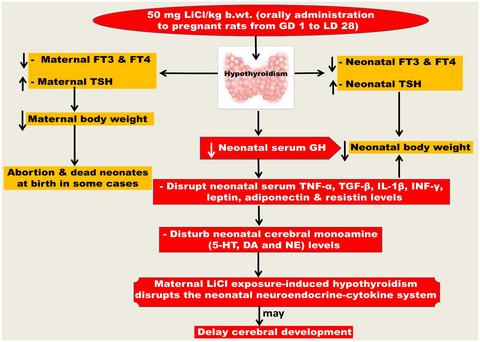当前位置:
X-MOL 学术
›
Int. J. Dev. Neurosci.
›
论文详情
Our official English website, www.x-mol.net, welcomes your
feedback! (Note: you will need to create a separate account there.)
Maternal lithium chloride exposure alters the neuroendocrine‐cytokine axis in neonatal albino rats
International Journal of Developmental Neuroscience ( IF 1.7 ) Pub Date : 2020-04-01 , DOI: 10.1002/jdn.10010 Dena A-E Mohammed 1 , Rasha R Ahmed 2 , R G Ahmed 1
International Journal of Developmental Neuroscience ( IF 1.7 ) Pub Date : 2020-04-01 , DOI: 10.1002/jdn.10010 Dena A-E Mohammed 1 , Rasha R Ahmed 2 , R G Ahmed 1
Affiliation

|
The aim of this work was to clarify whether maternal lithium chloride (LiCl) exposure disrupts the neonatal neuroendocrine‐cytokine axis. Pregnant Wistar rats were orally administrated 50 mg LiCl/kg b.wt. from gestational day (GD) 1 to postpartum day 28. Maternal administration of LiCl induced a hypothyroid state in both dams and their neonates compared to the control dams and neonates at lactation days (LDs) 14, 21 and 28, where the levels of serum free triiodothyronine (FT3) and free thyroxin (FT4) were decreased and the level of serum thyrotropin (TSH) level was increased. A noticeable depression in maternal body weight gain, neonatal body weight and neonatal serum growth hormone (GH) was observed on all examined postnatal days (PNDs; 14, 21 and 28). A single abortion case was recorded at GD 17, and three dead neonates were noted at birth in the LiCl‐treated group. Maternal administration of LiCl disturbed the levels of neonatal serum tumor necrosis factor‐alpha (TNF‐α), transforming growth factor‐beta (TGF‐β), interleukin‐1 beta (IL‐1β), interferon‐gamma (INF‐γ), leptin, adiponectin and resistin at all tested PNDs compared to the control group. This administration produced a stimulatory action on the level of neonatal cerebral serotonin (5‐HT) at PND 14 and on the level of neonatal cerebral norepinephrine (NE) at PNDs 21 and 28. However, this administration produced an inhibitory action on the level of neonatal cerebral dopamine (DA) at all examined PNDs and on the level of neonatal cerebral NE at PND 14 and the level of neonatal cerebral 5‐HT at PNDs 21 and 28 compared to the corresponding control group. Thus, maternal LiCl exposure‐induced hypothyroidism disrupts the neonatal neuroendocrine‐cytokine system, which delay cerebral development.
中文翻译:

母体氯化锂暴露改变新生白化大鼠的神经内分泌-细胞因子轴
这项工作的目的是澄清母体氯化锂 (LiCl) 暴露是否会破坏新生儿神经内分泌 - 细胞因子轴。怀孕的 Wistar 大鼠口服 50 毫克氯化锂/公斤体重。从妊娠第 1 天 (GD) 到产后第 28 天。与对照母鼠和哺乳天 (LDs) 14、21 和 28 的新生儿相比,母体给予 LiCl 会导致母鼠及其新生儿的甲状腺功能减退,其中血清水平游离三碘甲状腺原氨酸(FT3)和游离甲状腺素(FT4)降低,血清促甲状腺素(TSH)水平升高。在所有检查的产后天数(PND;14、21 和 28 天)都观察到母亲体重增加、新生儿体重和新生儿血清生长激素 (GH) 的显着下降。GD 17 记录了一个流产案例,LiCl 治疗组在出生时发现 3 名新生儿死亡。母亲服用氯化锂扰乱了新生儿血清肿瘤坏死因子-α(TNF-α)、转化生长因子-β(TGF-β)、白细胞介素-1β(IL-1β)、干扰素-γ(INF-γ)的水平与对照组相比,所有测试的 PND 的瘦素、脂联素和抵抗素。该给药对 PND 14 的新生儿大脑血清素 (5-HT) 水平和 PND 21 和 28 的新生儿大脑去甲肾上腺素 (NE) 水平产生刺激作用。 然而,该给药对 PND 水平产生抑制作用与相应的对照组相比,新生儿大脑多巴胺 (DA) 在所有检查的 PND 和 PND 14 的新生儿大脑 NE 水平和 PND 21 和 28 的新生儿大脑 5-HT 水平。因此,
更新日期:2020-04-01
中文翻译:

母体氯化锂暴露改变新生白化大鼠的神经内分泌-细胞因子轴
这项工作的目的是澄清母体氯化锂 (LiCl) 暴露是否会破坏新生儿神经内分泌 - 细胞因子轴。怀孕的 Wistar 大鼠口服 50 毫克氯化锂/公斤体重。从妊娠第 1 天 (GD) 到产后第 28 天。与对照母鼠和哺乳天 (LDs) 14、21 和 28 的新生儿相比,母体给予 LiCl 会导致母鼠及其新生儿的甲状腺功能减退,其中血清水平游离三碘甲状腺原氨酸(FT3)和游离甲状腺素(FT4)降低,血清促甲状腺素(TSH)水平升高。在所有检查的产后天数(PND;14、21 和 28 天)都观察到母亲体重增加、新生儿体重和新生儿血清生长激素 (GH) 的显着下降。GD 17 记录了一个流产案例,LiCl 治疗组在出生时发现 3 名新生儿死亡。母亲服用氯化锂扰乱了新生儿血清肿瘤坏死因子-α(TNF-α)、转化生长因子-β(TGF-β)、白细胞介素-1β(IL-1β)、干扰素-γ(INF-γ)的水平与对照组相比,所有测试的 PND 的瘦素、脂联素和抵抗素。该给药对 PND 14 的新生儿大脑血清素 (5-HT) 水平和 PND 21 和 28 的新生儿大脑去甲肾上腺素 (NE) 水平产生刺激作用。 然而,该给药对 PND 水平产生抑制作用与相应的对照组相比,新生儿大脑多巴胺 (DA) 在所有检查的 PND 和 PND 14 的新生儿大脑 NE 水平和 PND 21 和 28 的新生儿大脑 5-HT 水平。因此,











































 京公网安备 11010802027423号
京公网安备 11010802027423号